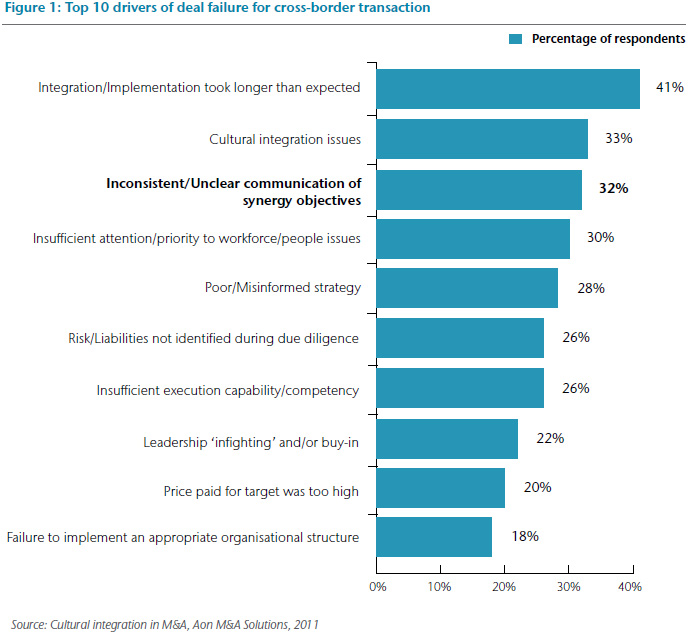.jpg)
Mastering the art of effective communication for deal success
The glue that holds and drives successful post-transaction goals & integration
The burning platform Everyone in Business & HR leadership is said to harp on how ‘effective communication’ is critical to deal success. This comes up consistently in M&A research studies done by various reputable M&A advisory firms. A study done by Aon across more than 150 companies also underscores ‘deal communication’ as one of the top five reasons for deal success (as illustrated below).

1. Case Study
Client situation
The deal was unprecedented and unique in many ways from their business goal and employee perspectives. Realising the deal value required some hard decisions and rapid implementation to be undertaken.
A number of issues revolved around the lack of a shared understanding of how a communication strategy should be created and how such a strategy should be communicated, e.g., leadership vs. HR-led, mailers vs. face-to-face meetings, etc.
Aon approach
Communication was going to be key to ensure that integration would be smooth and deal goals of business output, productivity, and workforce rationalisation would be met. A structured and transparent communication plan was thus formulated with clear timelines for the employees.
Value and impact
Potential complications due to lack of sufficient or clear communication with employees, which could have jeopardised the deal and integration goals, were avoided.
Let’s examine a few vital insights based on our extensive experience and research:
- Transaction-led situations, such as M&A, have fundamentally different business goals and metrics to define success.
- These goals, and the ensuing outcomes we want to drive, will very often differ according to function, geography, or business divisions, as each may be impacted differently.
- We need to hardwire the communication strategy, plan and implementation (tools & support) to the integration strategy, business goals and, if applicable, a staggered integration plan across either geographies or functions.
Once we have set out in detail the applicability and implications of the above to the particular deal situation, we then recommend and establish some guiding principles on communication that have proven to be very effective in consistently driving successful deal outcomes. A few guidelines that we have found to be universal across sectors, deal sizes, and geographies are outlined here:
A. Communicate what certainties you can or communicate a plan to get clarity on other aspects, but communicate clearly and quickly.
B. Endeavour to strongly link/tailor communication strategy and implementation to:
- the overall integration plan and objectives
- each legacy entity’s needs
- specific integrating functional needs
C. View the problem and outcomes from the employee’s viewpoint and prioritise accordingly.
D. Use different modes of communication i.e., emails, banners/posters, intranets, town halls, manager meetings, and face-to-face meetings, as appropriate for the message.
E. Strongly ‘brand’ the communication initiative to improve recall, credibility, and effectiveness.
F. Business should lead this initiative from planning to implementation with HR supporting it (and not the other way around).
Unpacking the problem
Driving ‘effective communication’ may sound simple, but in reality can be fairly complex, if you do not understand the exact contours of the problem as applied to your organisational and deal context.
We surfaced an ‘effective communication’ issue in an integration project a client was running across more than 15 countries in the Asia Pacific region. The communication plan created by the company failed to deliver a clear employee value proposition with respect to what changes employees should expect once they were on-boarded in the new company. There was also no communication created for Day11 for the acquired employees. Not knowing what to expect would have caused employees’ anxiety as well as entropy in the system. Smart clients realise this can be a big issue and make efforts to ensure that Day 1 is not disruptive, thus retaining employee productivity and ensuring that value-preserving, short-term goals are not impacted negatively.
Hence, the key is to have the right framework to unpack the problem and then to prioritise initiatives that will drive maximum impact. It is then critical to craft and execute the right steps to realise success factors and derail risks.
Authors:
Sharad Vishvanath
SVP & Partner, Regional MD Asia Pacific, Middle East & Africa
Aon Strategic Advisors & Transaction Solutions
[email protected]
Get in touch
